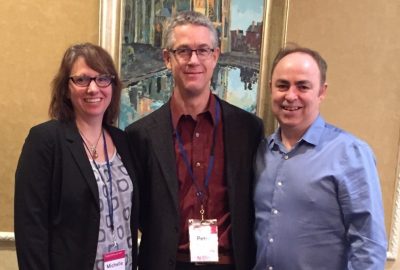by David Peacock, Michelle Nilson, Peter Andrée
Canadian community-campus engagement practitioners can learn a thing or two from the Brits, but we have some ideas to offer them too.

CFICE members Michelle Nilson, Peter Andree and David Peacock, represented CFICE at the Engage 2017! conference.
On December 6-7, 2017, we (Michelle Nilson, Peter Andrée, and David Peacock) represented Community First: Impacts of Community Engagement (CFICE) at the National Coordinating Centre for Public Engagement (NCCPE)’s annual Engage conference, held in Bristol, England.
Community Engagement thrives in the UK under the big tent term of ‘Public Engagement’, supporting outreach projects from genome editing to museums as well as funding for engaged research. And the NCCPE puts on a good show! The organization has been particularly successful in supporting public engagement professional staff in universities, and in producing tools such as the EDGE classification system to reward universities for their engagement activities.
We travelled to Bristol to renew Canadian-UK links in engagement and to learn more as we mobilize our own Canadian networks for social change through community partnered work.
Some highlights…
The conference keynotes were fascinating. In South Africa, the engagement imperative is a part of a wider social and political reconstruction in the post-apartheid era. Chancellor Nancy Cantor from Newark University gave a searing speech on the moral responsibilities of her community’s ‘anchor institution’. And the Chancellor of Keele university, in the north east of England, gave a more policy-oriented and pragmatic account of public engagement’s place among other more commercially-oriented knowledge exchange functions. Clearly the NCCPE leadership sees value in having all of these perspectives represented.
Additionally, throughout the conference, engagement professionals had ample opportunity to communicate directly with policy makers, large funders, and supportive academics.
A Canadian difference?
We experienced, however, something of a Canadian ‘difference’ during the Engaged Practitioner Learning Exchange pre-conference (a past partnership between NCCPE and Community-Based Research Canada) and when receiving feedback to our presentation.
The CFICE approach, centred on civil society partnerships with a social and ecological justice focus, found support from other participants, yet also inspired discussions on the scope of engagement activities and mandates beyond the social sector. When we asked what role national community umbrella organizations could play in a national movement for public/community engagement, we were a little surprised at some of the responses. In Canada, this seems to us to be critical to the success of a national movement for community-campus engagement. For our workshop participants, this seemed less vital, although interesting.

Participants listen to CFICE’s Engage 2017! conference presentation. ©NCCPE
What did we learn?
For Canadians practicing and researching community-campus engagement, there is much to envy about the coordination of higher education policy around engagement and the dedicated ‘third stream’ funding mechanisms for this work. This policy culture and the strength of the higher education sector in the UK have enabled NCCPE’s success, and universities and their partners have clearly benefited from its work.
Yet a typically Canadian, decentralized (ad hoc?) approach to community-campus engagement nonetheless has produced the conditions for differing modes of creative collaboration. Community activists, foundations and university-based engaged researchers and practitioners have had to build more grass roots, and horizontal forms of consent and cooperation. Arguably this has led to a stronger base for action and advocacy among community participants in community-campus engagement.
With this strong, community-anchored voice there seems less chance that socio-cultural development will come second to the needs of universities. That’s our hope, at least, as we progress this work in the Canadian context.
What are your thoughts? Share them in the comments section below!